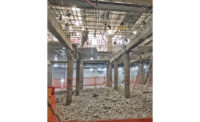...and level of care. Continuing care retirement community apartments typically range from $214,500 to $4.3+ million in entrance fees, with monthly fees ranging from $1,860 to $7,400.
Despite some bumpy starts, most university-affiliated communities are at or near capacity. Meadowood Retirement Community, which is affiliated with Indiana University, Bloomington, Ind., has a waiting list of 135 families, says executive director Susan Bookout. Meadowood is planning to expand, adding 60 freestanding assisted-living units, which the 27-year-old community eliminated in 1997 because the single-room-with-a-bath design was outmoded. The new units will be "a step up in quality" because of the clientele, says Paul Toddy, executive vice president of construction services for construction manager Mayer Najem Corp., Fishers, Ind. "We are going for LEED silver," adds Steve Schaecher, project architect with Schmidt Associates, Indianapolis.
| 74,985 Annual Potential Market for 55+ Multi-Family Apartments | ||
| Owners | Renters | |
| Numbers | 20,464,459 | 1,635,389 |
| Likely to Move to 55+ Rental | .08 | .14 |
| Percent move in 12 months | .03 | .113 |
| Annual U.S. Middle American Market | 49,114 | 25,871 |
The need is great and will only soar as the population ages. By 2026, people in the U.S. aged 65-plus will double to 71.5 million and nearly 70% of today's 65-year-olds will need long-term care, according to the American Association of Homes and Services for the Aging. Medicare does not pay for long-term care; nearly 40% of spending for long-term care comes from private funds, according to AAHSA.
The line between active adult communities and CCRCs increasingly will blur. The trend is for developers of active adult communities to look at adding a health-care component, even if it is an affiliation rather than an on-site facility, and for CCRCs to add a greater number of independent living residences, says architect John Birge, principal at RDG Schutte Wilscam Birge, Omaha, Neb. "Everybody's trying to figure it out," he says. The firm has been designing senior living communities for more than 40 years and is the architect for Oak Hammock and Canterbury Park in Atlanta’s Buckhead area, among others.
 Westcott Lakes at SouthWood Florida State University is launching Wescott Lakes at SouthWood in Tallahassee.
|
One example of the change is University Place, West Lafayette, Ind., which is affiliated with Purdue University. Mike Logan, executive director of University Place, says his "boutique CCRC," composed of 104 independent living units, 48 assisted living units and 30 private healthcare suites, was built in 2003 but may double the size of the independent living apartments, from the current minimum of about 600 sq ft to a minimum of 1,200 sq ft., among other enhancements to the community.
Another community, Holy Cross Village at the University of Notre Dame in Indiana, which also shares a campus with Holy Cross College, is finishing an expansion this fall that will provide units of up to 1,600 sq ft, vs the older units that were only about 700 sq ft, says Steve Kastner, executive director.
Florida State University is sponsoring a new community called Westcott Lakes at SouthWood in Tallahassee that is in the marketing phase. It will be a resort-style CCRC with nearly 230 residences and 44 club homes as well as long-term health-care units. Affiliations are being forged with the various colleges at FSU.
Residents are encouraged to stay active and many see the university setting as an excellent venue for that. "My next frontier is, can we do that kind of a model in skilled nursing," says Paula Panchuck, executive director of Lasell Village at Lasell College in Newton, Mass. "I think the academic life setting is going to have a big appeal. In terms of the active retiree, this may be the place."
One developer is beginning a foray into university-affiliated retirement communities with condominiums, which overall have suffered in the down housing market. Stephen Roof, executive vice president of ISA Properties LLC, Clemson, S.C., is working with Clemson University to build 74 condos with an average of 2,000 sq ft. The community will offer no continuing care. It will be three blocks from the Clemson campus – ISA is negotiating with the university now. The idea came from the Clemson alumni, says Roof. “The lenders don’t advance the funds until you have [commitments for] 50% of the sales,” he says. “Every hope is that it will move forward.”
A portion of the new senior housing also will be rentals as more communities make way for the more mobile seniors and aging baby boomers. In general, the rental market for seniors could really blossom, reaching a potential of 75,000 annually who are likely to move to 55-plus multifamily apartments, says researcher Wylde.
A majority of age 55-plus renters, 64%, are single, and 61% of current 55-plus renters in multi-family buildings have two bedrooms. “Just because it’s a single person doesn’t mean they want small,” Wylde told attendees of the boomers conference. Rentals can be “a significant competitor” to CCRCs, especially since demand outweighs the supply of them, but Wylde cautioned that the service-enriched market is changing with the blurring of lines. And, she added, “there’s a significant variation in penetration and preferences” in different regions of the U.S. But overall, “It is a terrific market and consumers do want it,” she says.
With the uncertainty of exactly how different baby boomers will be as seniors vs. previous generations, developers and designers struggle to stay ahead of the curve. “There’s a lot of experimentation going on,” says Gerard Badler, head of Campus Continuum Development Group, Newton, Mass., which focuses on active adult communities with affiliations with healthcare facilities nearby. “It’s not clear to anyone which models will be successful in the end.”



Post a comment to this article
Report Abusive Comment